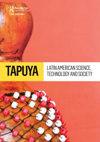The mirage of scientific productivity and how women are left behind: the Colombian case
IF 1.2
Q2 HISTORY & PHILOSOPHY OF SCIENCE
Tapuya: Latin American Science, Technology and Society
Pub Date : 2022-12-31
DOI:10.1080/25729861.2022.2037819
引用次数: 1
Abstract
ABSTRACT Equity, diversity and inclusion (EDI) in the workforce are paramount for the betterment of the scientific endeavor. Colombia is a country with great scientific potential, but also multiple long-lasting socioeconomical difficulties. Here, we provide a quantitative analysis of the temporal trajectories of gender parity in scientific publishing in Colombia. Data was dissected based on education level, researcher’s rank and research area, in order to elucidate differential patterns of scientific publishing. We controlled for gender-based differences in number of researchers by quantifying per capita scientific productivity. Our results show widespread gender disparity in scientific publishing persistent across time. Gender-based differences in per capita scientific publishing indicate that gender disparity persists even after controlling for differences in the number of researchers. Temporal trajectories revealed a decrease in women publishing in the medical sciences and a widening of the per capita publishing gender gap. Women senior researchers and women researchers with doctoral degrees had the lowest publishing participation within their group, suggesting access to postgraduate education or entering the workforce in themselves do not prevent women from being underrepresented. We highlight the need to understand the problem of underrepresentation in science and possible ways to address it beyond increasing the number of women researchers.科学生产力的海市蜃楼和女性如何被抛在后面:哥伦比亚的案例
摘要劳动力的公平、多样性和包容性(EDI)对科学事业的进步至关重要。哥伦比亚是一个具有巨大科学潜力的国家,但也存在多重长期的社会经济困难。在这里,我们对哥伦比亚科学出版中性别平等的时间轨迹进行了定量分析。以教育程度、科研人员职级和研究领域为基础对数据进行分析,以阐明科研出版的差异模式。我们通过量化人均科学生产力来控制基于性别的研究人员数量差异。我们的研究结果表明,科学出版领域普遍存在的性别差异一直存在。人均科学出版物的性别差异表明,即使在控制了研究人员数量的差异之后,性别差异仍然存在。时间轨迹显示,女性在医学领域的出版数量减少,人均出版性别差距扩大。女性高级研究人员和拥有博士学位的女性研究人员在她们的群体中发表论文的参与率最低,这表明获得研究生教育或自己进入劳动力市场并不能防止女性的代表性不足。我们强调有必要了解科学界代表性不足的问题,以及除了增加女性研究人员的数量之外解决这个问题的可能方法。
本文章由计算机程序翻译,如有差异,请以英文原文为准。
求助全文
约1分钟内获得全文
求助全文
来源期刊

Tapuya: Latin American Science, Technology and Society
Social Sciences-Social Sciences (all)
CiteScore
1.60
自引率
0.00%
发文量
39
审稿时长
19 weeks
 求助内容:
求助内容: 应助结果提醒方式:
应助结果提醒方式:


